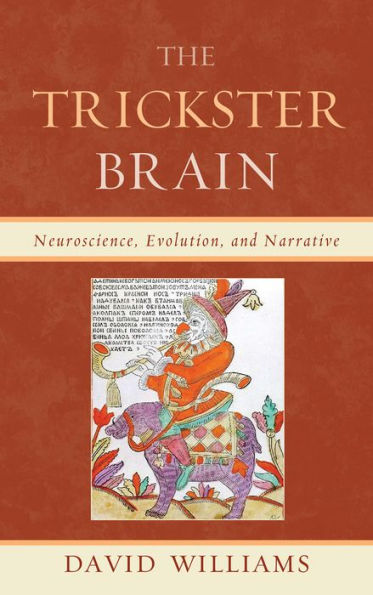5
1


Paperback
$57.99
-
PICK UP IN STORECheck Availability at Nearby Stores
Available within 2 business hours
Related collections and offers
57.99
In Stock
Overview
Until recently, scientific and literary cultures have existed side-by-side but most often in parallel universes, without connection. The Trickster Brain: Neuroscience, Evolution, and Nature by David Williams addresses the premise that humans are a biological species stemming from the long process of evolution, and that we do exhibit a universal human nature, given to us through our genes. From this perspective, literature is shown to be a product of our biological selves. By exploring central ideas in neuroscience, evolutionary biology, linguistics, music, philosophy, ethics, religion, and history, Williams shows that it is the circuitry of the brain’s hard-wired dispositions that continually create similar tales around the world: “archetypal” stories reflecting ancient tensions that arose from our evolutionary past and the very construction of our brains. The book asserts that to truly understand literature, one must look at the biological creature creating it. By using the lens of science to examine literature, we can see how stories reveal universal aspects of the biological mind. The Trickster character is particularly instructive as an archetypal character who embodies a raft of human traits and concerns, for Trickster is often god, devil, musical, sexual, silver tongued, animal, and human at once, treading upon the moral dictates of culture. Williams brings together science and the humanities, demonstrating a critical way of approaching literature that incorporates scientific thought.

Product Details
| ISBN-13: | 9780739188323 |
|---|---|
| Publisher: | Lexington Books |
| Publication date: | 10/18/2013 |
| Pages: | 314 |
| Product dimensions: | 6.00(w) x 8.90(h) x 0.90(d) |
About the Author
David Williams, PhD, has been a writer-in-residence at a number of universities and colleges, including Knox College and the Metropolitan State College of Denver. He is also an Emmy winning songwriter, cartoonist, and string musician with many CDs to his credit. Currently, he teaches in the Writing Program at the University of Colorado Boulder.
Table of Contents
IntroductionChapter 1: Searching for TricksterChapter 2: The Silver Tongued DevilArchetypesWhere is Science in the Study of Literature?Universal Human NatureTextual Authority vs. Empirical EvidenceHow Did Language Begin?ChomskySchema TheoryChapter 3: The Tricksterish BrainChapter 4: EvolutionChapter 5: The Brain of SexSex, Disease, and CompetitionDisplaysThe Sexiest AnimalsOrnamental MindChapter 6: The Brain of Love and WarSexual Selection and AltruismMonogamy?Women and WarCivilization and Enslavement of WomenWhy Love?The Power of Love: Women’s Songs of Love from AfghanistanChapter 7: The Brain of SongMusic and Language—Common RootsTwo CampsWhy Did Music and Language Split?Music and FoodSexual Selection for MusicTribal Songs for Every Aspect of LifeChapter 8: EthicsThe Falacy of the Naturalistic Fallacy: Is—OughtFairness and Justice in the Animal WorldChapter 9: Storytelling and the Theory of MindUnconsciousness & ConsciousnessTheory of MindChapter 10: The Brain of GodPotheism/Monotheism and the Search for MeaningWhy God? What Caused Religion? Origins of ReligionOther ExplanationsChapter 11: The Trickster of MythologyWhy Trickster?Trickster Biological OriginsChapter 12: A Swath of Trickster Stories from Oral LiteratureSex, Desire, and the BodySome Trickster Stories from Around the WorldCoyote Marries a Man (Plains Cree, North America)A Contest for Wives (Cochiti, North America)Legba (Fon, West Africa)Coyote Visits the Women (Assiniboine, North America)Coyote and His Anus (Nez Perce, North America)The Trickster Myth (Winnebago, North America) excerptsUncle Tompa (Tibet)Namaranganin (Aborigine, Australia)Coyote Sleeps with His Own Daughters (Southern Ute, North America)How Kwaku Ananse Got Aso in Marriage (Ashanti, Africa)Coyote Keeps his Dead Wife’s Genitals (Lipan Apache, North America)Chapter 13: Female TrickstersEvil Woman Trickster StoriesThe Toothed Vagina (Yurok, North America)Teeth in the Wrong Place (Ponca-Otoe, North America)The Witch Wife (Colombia)Proverbs 5, 3-8 (Hebrew)Clever/Good Women Trickster StoriesOld Man Coyote Meets Coyote Woman (Blackfoot, North America)The Most Precious Thing in the World (Hebrew)The Clever Daughter-in-Law (Kanda, India) The Wife who Refused to be Beaten (Kashmiri, India)One More Use for Artists (Gujerti, India)The Faithful Wife and the Woman Warrior (Tiwa, North America) A Pueblotale featuring Apache charactersIktome Sleeps with His Wife by Mistake (Brule Sioux, North America)Chapter 14: Literary FiltersChapter 15: Music and the TricksterLiterary FiltersMusic and the TricksterSinging the World Into Being: Creation Stories with SongApache Creation Story (North America)Creation Story (Hopi, North America)Bunjil The Creator #1 (Aboriginal, Australian)Diné (or Navajo) (North America)Mythic Trickster Musicians and SingersAjapa and the Roasted-Peanut Seller (Yoruba, Africa)Coyote Giving (Paiute, North America)Hermes (Greek)Hanuman (India)The Zande Trickster, Tule; The Bushman (Africa)Chapter 16: A Swath of Other Trickster Stories from Around the WorldThe Wonderful Tar Baby Story (African American)John (African American)How the Wicked Tanuki was Punished (Japan) Fox and Snake—Good is Repaid with Evil (Venezuela)Sun Wu-K’Ung, The Monkey King (China)Dionysus (Greek)The Wanderings of Dionysus (Greek)Prometheus (Greek)Pandora (Greek)Orpheus (Greek)Coyote and the Shadow People (Nez Perce, America)The Infancy Gospel of Thomas (Apocrophy Gospel, 2nd century)Jesus Child (Quichua, Ecuador) Jesus Christ (Cakchiquel Maya (Guatemala)/ Matias Sicajan)We-Gyet (‘Ksan, Northwest Coast)Chapter 17: The Trickster PersonifiedThe Heyoka CeremonyBuddhist ClownsJewish and Christian ClownsOther ClownsIslamic ClownJestersKannada; Tamil; Telugu (India)How Tamali Rama Became A Jester (India)Tamali Rama Recites Story of Ramayna (India)Tyll Ulenspiegel’s Merry Prank (Germany)Quevedo and the King (Mexico)Chapter 18: Blues & Courting TrickstersChapter 19: Trickster in Written Literature Chapter 20: Trickster Was WanderingWhat People are Saying About This
Kayt Sukel
In The Trickster Brain, David Williams brings together the seemingly incompatible worlds of neuroscience, anthropology and literature with wit and scholarly flair. Williams does not shy away from the more contradictory elements of human nature in this ambitious book, and he leaves the reader with the knowledge that our own brains are tricking us into a better understanding of our most elemental natures.
Peter Swirski
David Williams tricks the reader into following in his fleet footsteps into the land of neuroscience, evolution, music, and other seemingly non-literary areas in order to flesh out something important about our evolutionary brains, namely our propensity for weaving stories.
From the B&N Reads Blog
Page 1 of
